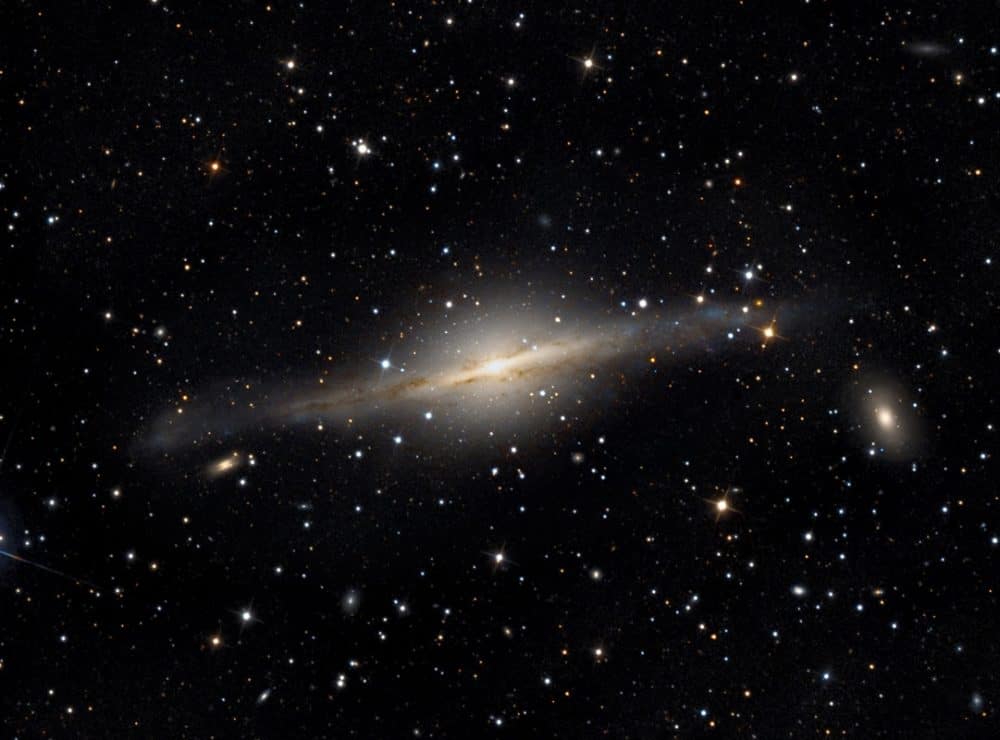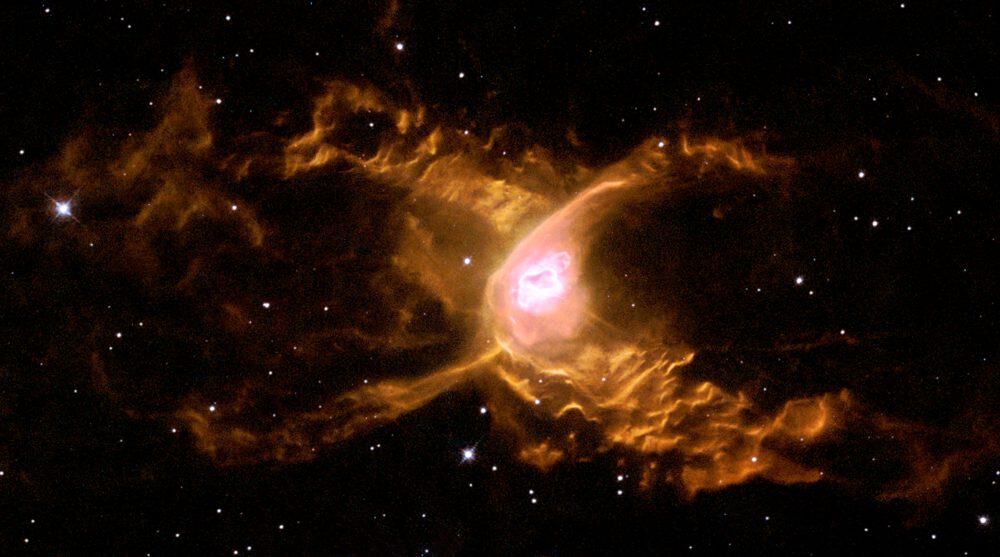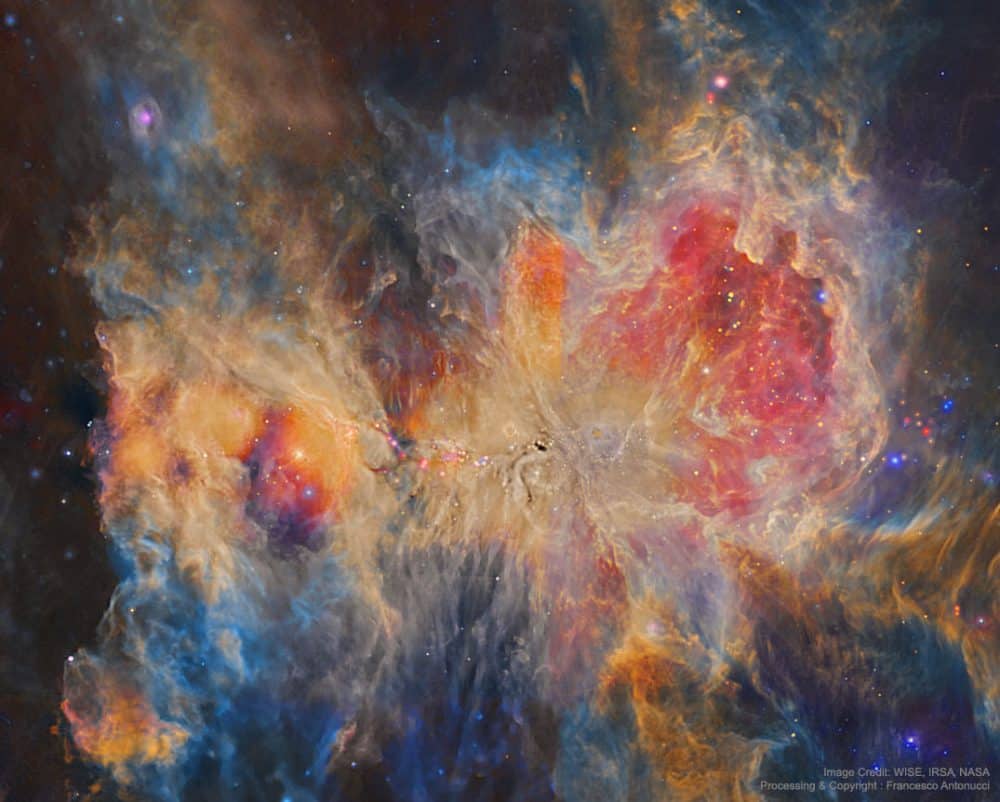Blog
NGC 2282 (pictured here). Not much research has been carried out regarding this region, but its size and distance have been determined; it lurks about 5,500 light-years from Earth, and spans approximately 5 light-years across.
Found in the constellation of Monoceros, NGC 2282 is believed to be the site of ongoing star formation activity, perhaps giving life to a few hundred stars. Many of which are somewhere between 5 and 10 million years old, basically newborns. What’s more is that at least 9% are pre main-sequence.
Based on their infrared signature, research indicates that the cluster is situated on the outskirts of a molecular cloud, which may aid in the formation of the reflection nebula this image — taken by Adam Block of the Mount Lemmon Sky Center — brilliantly displays.
more...Paul Wertico (born January 5, 1953 in Chicago, Illinois) is an American drummer. He gained recognition as a member of the Pat Metheny Group from 1983 until 2001, leaving the group to spend more time with his family and to pursue other musical interests.
He formed the Paul Wertico Trio and collaborated with Larry Coryell, Kurt Elling, and Jeff Berlin. From 2000 to 2007, he was a member of SBB, the platinum-record-winning Polish progressive rockband. Wertico was a member of the Larry Coryell Power Trio until Coryell’s death in 2017.
more...Elizabeth “Libba” Cotten (née Nevills) (January 5, 1893 – June 29, 1987) was an American blues and folk musician, singer, and songwriter. A self-taught left-handed guitarist, Cotten developed her own original style. She played a guitar strung for a right-handed player, but played it upside down, as she was left-handed. This position required her to play the bass lines with her fingers and the melody with her thumb. Her signature alternating bass style has become known as “Cotten picking”.
Cotten was born in 1893 in Chapel Hill, North Carolina, to a musical family. Her parents were George Nevill (also spelled Nevills) and Louisa (or Louise) Price Nevill. Elizabeth was the youngest of five children. At age seven, she began to play her older brother’s banjo. “From that day on,” she said, “nobody had no peace in that house.” By the age of eight, she was playing songs. At the age of 11, after scraping together some money as a domestic helper, she bought her own guitar. The guitar, a Sears and Roebuck brand instrument, cost $3.75 (equivalent to $105 in 2018). Although self-taught, she became proficient at playing the instrument. By her early teens she was writing her own songs, one of which, “Freight Train“, became one of her most recognized. She wrote the song in remembrance of a nearby train that she could hear from her childhood home. The 1956 UK recording of the song by Chas McDevitt and Nancy Whiskey was a major hit and is credited as one of the main influences on the rise of skiffle in the UK.
more...Alioune Kassé was born in Dakar, Senegal. He belongs to the Tukulor ethnic group and is a writer, composer and player.
more...It’s hard to describe the music of Indonesian group Senyawa. The duo makes experimental music that crosses various musical boundaries. Singer Rully Shabara uses various forms of vocals, ranging from shamanic throat sounds to whispered lyrics in various layers. Multi-instrumentalist Wukir Suryadi plays a wide range of musical instruments that include conventional ones as well as homemade devices.
more...NGC 5084 is a lenticular galaxy in the constellation of Virgo. It is located at a distance of circa 80 million light years from Earth, which, given its apparent dimensions, means that NGC 5084 is at least 200,000 light years across. It is one of the largest and most massive galaxies in the Virgo Supercluster. It was discovered by William Herschel on March 10, 1785. The galaxy is seen nearly edge-on, with inclination 86°, and features a warped disk and large quantities of HI gas extending along the disk, probably accumulated after multiple accretions of smaller galaxies.
more...John McLaughlin (born 4 January 1942), also known as Mahavishnu John McLaughlin, is an English guitarist, bandleader and composer. His music includes many genres of jazz which he coupled with elements of rock, Indian classical music, Western classical music, flamenco and blues to become one of the pioneering figures in fusion.
After contributing to several key British groups of the early 1960s McLaughlin made Extrapolation, his first album as a bandleader, in 1969. He then moved to the U.S., where he played with Tony Williams‘s group Lifetime and then with Miles Davis on his electric jazz-fusion albums In a Silent Way, Bitches Brew, Jack Johnson, and On the Corner.
His 1970s electric band, the Mahavishnu Orchestra, performed a technically virtuosic and complex style of music that fused electric jazz and rock with Indian influences.
McLaughlin has been cited as an influence by a number of prominent musicians. He is a Grammy Award winner and has been awarded multiple “Guitarist of the Year” and “Best Jazz Guitarist” awards from magazines such as DownBeat and Guitar Player based on reader polls. In 2003, he was ranked 49th in Rolling Stone magazine’s list of the “100 Greatest Guitarists of All Time“. In 2009, DownBeat included McLaughlin in its unranked list of “75 Great Guitarists”, in the “Modern Jazz Maestros” category. In 2012, Guitar World magazine ranked him #63 on its top 100 list. In 2010, guitarist Jeff Beck called him “the best guitarist alive”. McLaughlin was also referred to as the best guitarist alive by Pat Metheny.
https://www.youtube.com/watch?v=b9w8Py9pcpY
more...
Frank Wellington Wess (January 4, 1922 – October 30, 2013) was an American jazz saxophonist and flautist. In addition to his extensive solo work, Wess is remembered for his time in Count Basie‘s band from the early 1950s into the 1960s. Critic Scott Yannow described him as one of the premier proteges of Lester Young, and a leading jazz flautist of his era—using the latter instrument to bring new colors to Basie’s music.
Wess was considered one of the best jazz flautists of his time. From 1959 to 1964, he won the Down Beat magazine critics’ poll for flute.
He was a member of Clark Terry‘s big band from 1967 into the 1970s and played in the New York Jazz Quartet (with Roland Hanna). He also did a variety of work for TV. In 1968 he contributed to the album The Jazz Composer’s Orchestra. He played tenor and alto sax, doubling on flute throughout his career.
more...Huge waves are sculpted in this two-lobed nebula some 3000 light-years away in the constellation of Sagittarius. This warm planetary nebula harbours one of the hottest stars known and its powerful stellar winds generate waves 100 billion kilometres high. The waves are caused by supersonic shocks, formed when the local gas is compressed and heated in front of the rapidly expanding lobes. The atoms caught in the shock emit the spectacular radiation seen in this image.
more...James Carter (born January 3, 1969) is an American jazz musician. He is the cousin of jazz violinist Regina Carter.
On May 31, 1988, at the Detroit Institute of Arts (DIA), Carter was a last-minute addition for guest artist Lester Bowie, which turned into an invitation to play with his new quintet (forerunner of his New York Organ Ensemble) in New York City that following November at the now defunct Carlos 1 jazz club. This was pivotal in Carter’s career, putting him in musical contact with the world, and he moved to New York two years later. He has been prominent as a performer and recording artist on the jazz scene since the late 1980s, playing saxophones, flute, and clarinets.
On his album Chasin’ the Gypsy (2000), he recorded with his cousin Regina Carter, a jazz violinist.
Carter has won Down Beat magazine’s Critics and Readers Choice award for baritone saxophone several years in a row. He has performed, toured and played on albums with Lester Bowie, Julius Hemphill, Frank Lowe & the Saxemble, Kathleen Battle, the World Saxophone Quartet, Cyrus Chestnut, Wynton Marsalis, Dee Dee Bridgewater and the Mingus Big Band.
https://www.youtube.com/watch?v=1MFRhQs8aig
more...Herbert Horatio Nichols (3 January 1919 – 12 April 1963) was an American jazz pianist and composer who wrote the jazz standard “Lady Sings the Blues“. Obscure during his lifetime, he is now highly regarded by many musicians and critics.
He was born in San Juan Hill, Manhattan in New York City, to parents from St. Kitts and Trinidad, and grew up in Harlem. During much of his life he took work as a Dixieland musician while working on the more adventurous kind of jazz he preferred. He is best known today for these compositions, program music that combines bop, Dixieland, and music from the Caribbean with harmonies from Erik Satie and Béla Bartók.
His first known work as a musician was with the Royal Barons in 1937, but he did not find performing at Minton’s Playhouse a few years later a very happy experience. The competition didn’t suit him. However, he did become friends with pianist Thelonious Monk even if his own critical neglect would be more enduring.
more...The Great Nebula in Orion is an intriguing place. Visible to the unaided eye, it appears as a small fuzzy patch in the constellation of Orion. But this image, an illusory-color four-panel mosaic taken in different bands of infrared light with the Earth orbiting WISE observatory, shows the Orion Nebula to be a bustling neighborhood of recently formed stars, hot gas, and dark dust. The power behind much of the Orion Nebula (M42) is the stars of the Trapezium star cluster, seen near the center of the featured image. The orange glow surrounding the bright stars pictured here is their own starlight reflected by intricate dust filaments that cover much of the region. The current Orion Nebula cloud complex, which includes the Horsehead Nebula, will slowly disperse over the next 100,000 years.
more...Troy Andrews (born January 2, 1986), also known by the stage name Trombone Shorty, is an American musician, producer, actor and philanthropist from New Orleans, Louisiana. He is best known as a trombone and trumpet player but also plays drums, organ, and tuba. He has worked with some of the biggest names in rock, pop, jazz, funk, and hip hop. Andrews is the younger brother of trumpeter and bandleader James Andrews and the grandson of singer and songwriter Jessie Hill. Other musical family members are cousins Glen David Andrews and the late Travis “Trumpet Black” Hill. Andrews began playing trombone at age four, and since 2009 has toured with his own band, Trombone Shorty & Orleans Avenue.
Troy Andrews was born in New Orleans and grew up in the Tremé neighborhood. Troy graduated in 2004 from Warren Easton High School. At the age of 4, he appeared onstage with Bo Diddley at the New Orleans Jazz & Heritage Festival. He participated in brass band parades as a child, becoming a bandleader by the age of six. In his teens, he was a member of the Stooges Brass Band. He attended the New Orleans Center for Creative Arts (NOCCA) along with fellow musician Jon Batiste.
more...Little Smokey Smothers (January 2, 1939 – November 20, 2010) was an African-American Chicago blues guitarist and singer. His elder brother was the bluesman Otis “Big Smokey” Smothers (died 1993), with whom he was sometimes confused.
Albert Abraham “Abe” Smothers was born in Tchula, Mississippi, learned to play the guitar at the age of 15, and relocated to Chicago two years later.He soon appeared on stage, playing with Arthur “Big Boy” Spires, Magic Sam, Otis Rush and Lazy Bill Lucas. In 1958 he joined up with Howlin’ Wolf, and he accompanied Wolf in a recording session for Chess Records the following year. Tracks Smothers contributed to include “I’ve Been Abused”, “Howlin’ for My Darling”. and “Mr. Airplane Man”
more...More Posts
- Masabumi Kikuchi Day
- Piano Red Day
- World Music with Cameron de las Isla y Paco de Lucia
- Daily Roots with Burning Spear
- 2018 Beau Koo Jacks-Everything I Do Gonna Be Funky 1-25-2018 @ the Amsterdam Benefit for Tom Zosel
- The Cosmos with IC 4628
- Esperanza Spalding Day
- Wynton Marsalis Day
- Chuck Berry Day
- World Music with Andelucious
- Daily Roots with Lloyd Parks and Joseph Cotton
- The Cosmos with Sh2-279
- Barney Kessel Day
- Cozy Cole Day
- World Music with Putokazi
- Daily Roots with Slimmah Sound/Dan I
- The Cosmos with NGC 3717
- Roy Hargrove Day
- Big Joe Williams Day
- World Fusion with Nawang Khechog & R. Carlos Nakai



